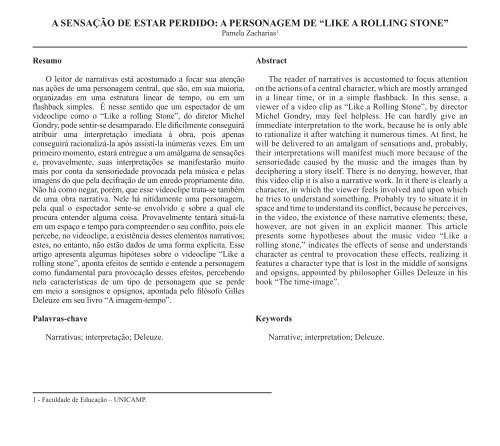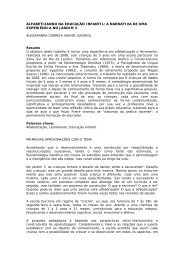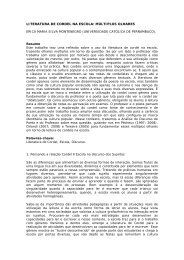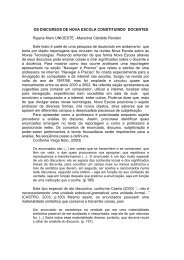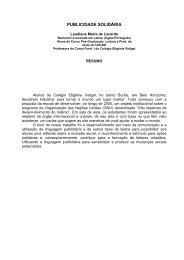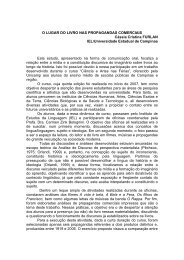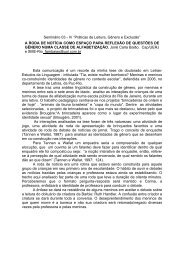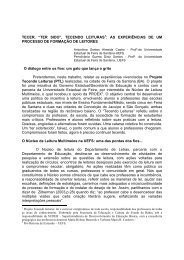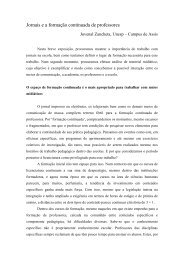Artigos do 18° COLE publicados na revista LTP - 9ª parte
Artigos do 18° COLE publicados na revista LTP - 9ª parte
Artigos do 18° COLE publicados na revista LTP - 9ª parte
Create successful ePaper yourself
Turn your PDF publications into a flip-book with our unique Google optimized e-Paper software.
Resumo<br />
A SENSAÇÃO DE ESTAR PERDIDO: A PERSONAGEM DE “LIKE A ROLLING STONE”<br />
Pamela Zacharias 1<br />
O leitor de <strong>na</strong>rrativas está acostuma<strong>do</strong> a focar sua atenção<br />
<strong>na</strong>s ações de uma perso<strong>na</strong>gem central, que são, em sua maioria,<br />
organizadas em uma estrutura linear de tempo, ou em um<br />
fl ashback simples. É nesse senti<strong>do</strong> que um especta<strong>do</strong>r de um<br />
videoclipe como o “Like a rolling Stone”, <strong>do</strong> diretor Michel<br />
Gondry, pode sentir-se desampara<strong>do</strong>. Ele difi cilmente conseguirá<br />
atribuir uma interpretação imediata à obra, pois ape<strong>na</strong>s<br />
conseguirá racio<strong>na</strong>lizá-la após assisti-la inúmeras vezes. Em um<br />
primeiro momento, estará entregue a um amálgama de sensações<br />
e, provavelmente, suas interpretações se manifestarão muito<br />
mais por conta da sensoriedade provocada pela música e pelas<br />
imagens <strong>do</strong> que pela decifração de um enre<strong>do</strong> propriamente dito.<br />
Não há como negar, porém, que esse videoclipe trata-se também<br />
de uma obra <strong>na</strong>rrativa. Nele há nitidamente uma perso<strong>na</strong>gem,<br />
pela qual o especta<strong>do</strong>r sente-se envolvi<strong>do</strong> e sobre a qual ele<br />
procura entender alguma coisa. Provavelmente tentará situá-la<br />
em um espaço e tempo para compreender o seu confl ito, pois ele<br />
percebe, no videoclipe, a existência desses elementos <strong>na</strong>rrativos;<br />
estes, no entanto, não estão da<strong>do</strong>s de uma forma explícita. Esse<br />
artigo apresenta algumas hipóteses sobre o videoclipe “Like a<br />
rolling stone”, aponta efeitos de senti<strong>do</strong> e entende a perso<strong>na</strong>gem<br />
como fundamental para provocação desses efeitos, perceben<strong>do</strong><br />
nela características de um tipo de perso<strong>na</strong>gem que se perde<br />
em meio a sonsignos e opsignos, apontada pelo fi lósofo Gilles<br />
Deleuze em seu livro “A imagem-tempo”.<br />
Palavras-chave<br />
Narrativas; interpretação; Deleuze.<br />
1 - Faculdade de Educação – UNICAMP.<br />
Abstract<br />
The reader of <strong>na</strong>rratives is accustomed to focus attention<br />
on the actions of a central character, which are mostly arranged<br />
in a linear time, or in a simple fl ashback. In this sense, a<br />
viewer of a video clip as “Like a Rolling Stone”, by director<br />
Michel Gondry, may feel helpless. He can hardly give an<br />
immediate interpretation to the work, because he is only able<br />
to ratio<strong>na</strong>lize it after watching it numerous times. At fi rst, he<br />
will be delivered to an amalgam of sensations and, probably,<br />
their interpretations will manifest much more because of the<br />
sensoriedade caused by the music and the images than by<br />
deciphering a story itself. There is no denying, however, that<br />
this video clip it is also a <strong>na</strong>rrative work. In it there is clearly a<br />
character, in which the viewer feels involved and upon which<br />
he tries to understand something. Probably try to situate it in<br />
space and time to understand its confl ict, because he perceives,<br />
in the video, the existence of these <strong>na</strong>rrative elements; these,<br />
however, are not given in an explicit manner. This article<br />
presents some hypotheses about the music video “Like a<br />
rolling stone,” indicates the effects of sense and understands<br />
character as central to provocation these effects, realizing it<br />
features a character type that is lost in the middle of sonsigns<br />
and opsigns, appointed by philosopher Gilles Deleuze in his<br />
book “The time-image”.<br />
Keywords<br />
Narrative; interpretation; Deleuze.


